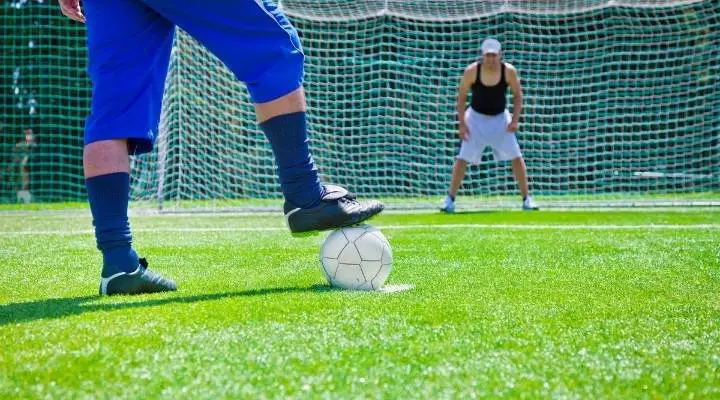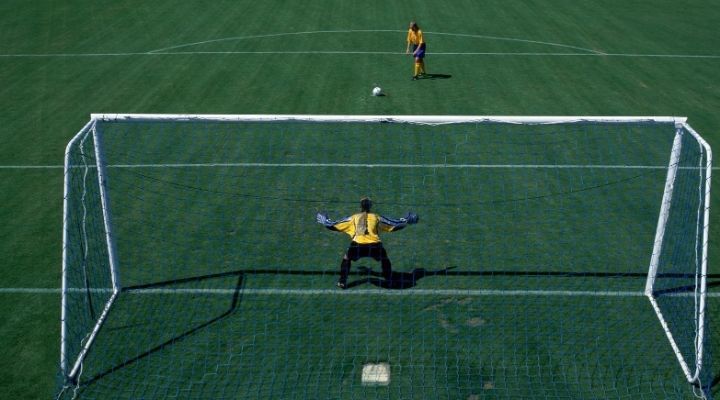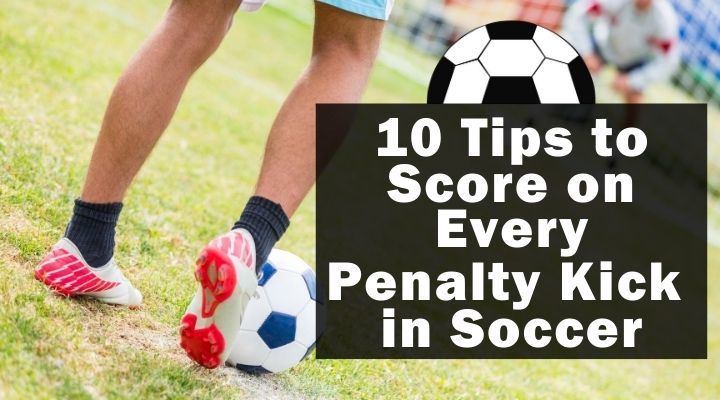10 Tips to Score on Every Penalty Kick in Soccer
Taking a penalty in soccer can be daunting and intimidating because all the pressure and expectation to score falls on you, the taker.
But you'll find that by keeping calm, focusing on your technique, and deciding in advance where you'll place the ball, you’ll be able to slot it past the opposition's keeper with ease.
While taking penalties can be stressful, practising often puts you in control of the situation and means that you'll approach the penalty spot with confidence, knowing that you have the technique and talent to bury it.
In addition to this, practising penalties also allows you to improve your striking technique and your ability to keep calm and focused in a pressure-filled environment.
In this article, we'll take a look at what a soccer penalty kick is and then go over some tips and tricks on how to bury your spot kick past the keeper, time and time again.
What Is a Penalty Kick in Soccer?
Before we move on to how to score penalties, just what exactly is a penalty kick and when is one awarded?
A soccer penalty kick (sometimes called a penalty, PK, or spot kick) is when a player is allowed to take a shot on goal with only the opposition's keeper before them.
This shot is taken from the penalty spot in the opponent's penalty box.
As this offers teams a great opportunity to score a goal, taking penalties is often a pressure-laden affair as the player taking the penalty is always expected to bury it past the keeper.
As penalties often determine the outcome of matches, teams usually have a designated penalty taker whose responsibility is to grab the ball, place it on the spot, and score each time.
When taking the penalty, they’re allowed to stagger their run and make feinting movements, but once they reach the ball, they must shoot it.
According to the penalty kick rules, the ball should be stationary when they take the kick and move forward when they strike it.
No other players besides the penalty taker and the keeper should be in the box, with the keeper remaining on their line until the ball is struck.
Once the penalty has been taken, the kicker isn’t allowed to touch the ball again until another player has touched it or it has gone out of play.

When Is a Penalty Kick Awarded?
During a match, penalties may be awarded for different infractions that occur in the penalty area.
Such as:
> When a player other than the keeper handles the ball in their own box
> When a player is careless, reckless, or uses excessive force when charging at, jumping at, kicking (or attempting to kick), striking (or attempting to strike), tackling, or tripping (or attempting to trip) an opponent in their own box
> Holding, pushing, or impeding an opponent in their own box
> Fighting, biting, or spitting at an opponent in their own box
The penalty may be retaken if the goalkeeper comes too far off of their line to save it or if another player enters the box before the spot kick has been taken.
Besides penalties that are awarded during matches, teams may have to contest a penalty shootout from time to time.
These are generally held in tournaments or cup competitions to determine the winner if a match ends goalless.
Consequently, all players on a team should feel comfortable and confident taking penalties, especially if they know that a shootout could arise at the end of a match.
Now that we've looked at what a penalty is and some of the rules and regulations surrounding them, let's move on to some tips and tricks that can help you score penalties.
Tips to Score on Every Penalty Kick in Soccer
As they’re a unique opportunity to score a goal, a lot of pressure falls on penalty takers to bury each spot kick they take.
Matches and championships can be lost by missed penalties, so it’s a good idea to prepare as much as possible, ideally at the end of each training session.
Aside from getting you used to facing down the keeper in a pressure-filled environment, practising penalties also allows you to hone your technique, build up a spot kick routine, and increase your self-belief and confidence.
By following these tips and tricks, you'll find that you'll be dispatching penalties past goalkeepers with aplomb with barely a second thought to spare for the intimidating atmosphere going on around you.
1. Practice, Practice, Practice
As with everything, practice, effort, and hard work determine just how good you get at penalties.
Even the best players struggle to score spot kicks and this is because the pressure-filled occasion gets to them and they miss their penalty.
As such, you really want to practice them as often as possible as this will prepare you to face the opposition's goalkeeper and keep calm and focused while taking your spot kick.
It’s best to practice penalties at the end of a training session as this mirrors game situations where you may already be tired from haring around the pitch.
By practising regularly, you build up a routine and allow your body and brain to get used to the motion and movement of taking penalties.
Repetition is crucial because this turns the process into something automatic.
2. Build a Routine
By building up a routine, you familiarise your body and brain with the act of taking penalties so that it almost becomes second nature.
The act of doing the same thing over and over again also helps you to focus and shut out what’s going on around you.
This is because you instead think about placing the ball on the spot, deciding where you'll strike it, step back the same distance you always do, and then wait for the whistle and place it where you wanted it to go.
By normalising the situation, you take the pressure out of the occasion which allows you to keep calm and score the penalty.
3. Hone Your Technique
While you’re practising and building a routine, you’re also honing your striking technique and accuracy which are invaluable skills to scoring penalties.
Shooting the ball with the inside of your foot will allow you greater control and precision over the strike while kicking it with your laces will result in a more powerful yet harder to control shot.
Your run up and foot placement is also key to taking penalties, so work out what works best for you by trying several different techniques and approaches.
See what you prefer and what seems to work the best and then hone your technique by practising all the time.
4. Experiment and Master Different Approaches
While some players opt for pace and power, others go for precision with yet others such as Sergio Ramos and Bruno Fernandes going for a panenka or hop, skip and shoot approach.
At the end of the day, it doesn't matter how you shoot your penalty just as long as it ends up in the back of the net.
Different players feel comfortable with different approaches, so it’s worth experimenting with a couple of shooting styles before you find the perfect one for you.
Even then, it’s a good idea to keep practising until you can confidently dispatch penalties in a couple of different ways.
This leaves the goalkeeper second-guessing how you'll shoot which makes it harder for them to save your shot.
5. Learn to Fool the Keeper
Besides honing your striking technique and shooting abilities, you also want to learn how to fool the goalkeeper and send them the wrong way or leave them rooted to the spot.
While your shot needs to be accurate and powerful enough for it to end up in the back of the net, it’s also useful if you can give them the eyes, position your body, or line up your run so that they dive in the wrong direction.
Part of fooling the keeper comes down to having several different shooting techniques which makes it very hard for the goalkeeper to predict what you’re going to do.
This is why keepers still haven't managed to stop Ramos from consistently scoring his cheeky chipped penalties.
6. Pick a Spot and Stick to It
Goalkeepers barely stand a chance if you just ignore their distractionary tactics, keep your cool, and shoot the ball hard and true.
The key to this is picking a spot and sticking with it and not changing your decision at the last moment.
If you do this, you’re more liable to miss the target or have your half-hearted penalty saved.
Practicing and building a routine again influence the decision you make as you’ll feel a lot more confident and comfortable aiming for certain parts of the goal.
While penalties arrowed into the top corner of the goal certainly look emphatic, keeping your strike low is often the best thing to do if you want to be certain of hitting the target.
Smashing the ball down the middle can also work if you’re certain that the keeper is going to dive out of the way.
Whatever decision you make, just be sure to commit to it and strike the ball cleanly and accurately when you do.
7. Relax, Focus, and Breathe
In the heat of the moment, it can be very hard to remain calm and keep focused, especially when the opposition team is trying their best to put you off.
Many players lose their cool and sky their shot or shoot it wide without even forcing the goalkeeper into a save.
This, however, shouldn't occur if you keep calm, take a couple of deep breaths and shut everything else out.
The idea is that by practising all the time, building up a routine, and honing various techniques and approaches, the motion of taking a penalty becomes natural and stress-free.
By practicing so much that it almost becomes second nature, you take the pressure out of the occasion and allow yourself to relax, focus, and score.
8. Be Confident
Practising taking penalties helps you to improve your striking technique, accuracy, and conversion rate which in turn increases your self-belief and confidence.
This helps you approach each penalty with a positive state of mind, certain that you're going to bury it past the keeper.
While practice makes perfect, believing that you'll score before you even step up to take the penalty also helps you to succeed, block out distractions, and almost will the ball into the back of the net.
Being confident and trusting in your abilities also helps you to bounce back should you ever miss a penalty, safe in the knowledge that you'll score the next one.
9. Visualise Success
A great way to increase your confidence and take control of the moment is to visualise scoring the penalty kick before you've even stepped up to take it.
Aside from helping you block out what's going on around you, visualising the ball striking the back of the net helps you decide where you're going to place it and the technique you're going to use to do that.
When you visualise yourself scoring, you don't want to stare at the particular spot at which you're going to aim.
Simply keep it in your mind's eye and then act it out on the pitch.
10. Ask for Feedback and Advice
Besides practising and perfecting your penalty-taking techniques, you're also going to want to ask your coaches and teammates for feedback and advice on how you’re doing.
The goalkeepers you’re practising with should also be able to give you some great pointers on what you’re doing right and what you could be doing a bit better.
In addition to this, it’s well worth researching different penalty techniques online as well as watching YouTube videos of how famous spot kick takers score time and time again.
This will help you hone and improve your technique, learn different approaches, and master the art of scoring penalties.

Conclusion
Although taking penalties can be a stressful and pressure-laden affair that determines whether your team wins or loses a match, with practice, patience, and perseverance, you can score them every time.
Besides practising and perfecting your striking technique, power, and accuracy, you should also build a routine and visualise success.
In doing so, you’ll increase your confidence and self-belief.
This helps you approach each soccer penalty kick in a positive state of mind, certain that you’re going to score.
With practice, effort, hard work, and the right tips and tricks up your sleeve, you too can bury your penalty past the keeper time and time again.

